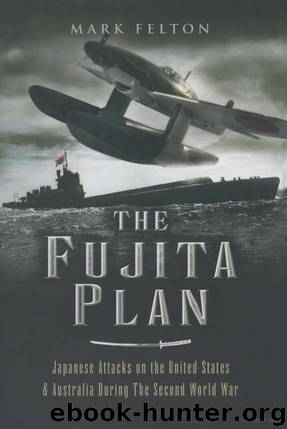The Fujita Plan: Japanese Attacks on the United States and Australia During the Second World War by Mark Felton

Author:Mark Felton [Felton, Mark]
Language: eng
Format: epub
Tags: Campaigns, Espionage & Intelligence, World War 2
ISBN: 9781844154807
Amazon: 1844154807
Goodreads: 855083
Publisher: Pen & Sword
Published: 2006-11-14T05:00:00+00:00
Submarines were immediately dispatched along with midget submarines from the tender Chiyoda, all coming under the designation Eastern Advanced Detachment (submarines I-22, I-24, I-27, I-28 and I-29) and headed for Australia and New Zealand. The I-29, under Lieutenant-Commander Juichi Izu, arrived off Sydney on 13 May, and three days later attacked her first ship. Izu intercepted a Soviet freighter, the 5,135-ton Wellen fifty miles south-east of Newcastle, New South Wales, and launched two torpedoes at her. Both missed their target, so Izu surfaced the I-29 and had his deck-gun brought into action. Japan and the Soviet Union were not at war at this time, so Izu’s actions were dangerous and could have caused a diplomatic row with the one power Japan was keen not to antagonize. Although three Russian sailors were wounded, no significant damage was done to the Soviet ship, and Izu gave up and submerged.
The significance of this action was the suspension of all ship movements between Sydney and Newcastle for twenty-four hours, while a group of Australian corvettes searched in vain for the Japanese submarine. The I-29 motored quietly back to Sydney and launched her aerial reconnaissance of the port. As a result of the I-29’s aerial reconnaissance of Sydney Harbour on 23 May, the Eastern Detachment Commander, Captain Hankyu Sasaki, ordered the force to begin making preparations to attack the large force of Allied warships noted to be in the harbour. Sasaki, aboard the I-21 then engaged in reconnoitring the city of Auckland in New Zealand, sent a report of the reconnaissance mission to Admiral Komatsu, a radio transmission that was picked up and partially decoded by the joint US and Australian Navy’s Fleet Radio Unit, Melbourne (FRUMEL). However, even though the Allies had broken the Japanese codes, no action was taken to stiffen the defences around Sydney. The I-29’s Glen floatplane piloted by Chief Warrant Officer Susumu Ito had recorded a collection of warships and merchant vessels inside Sydney Harbour. Ito and his observer had seen the heavy cruisers USS Chicago and HMAS Canberra, along with the light cruisers USS Perkins and HMAS Adelaide. Other warships in the harbour included the minelayer HMAS Bungaree, the armed merchant cruisers Kanimbla and Westralia, and the corvettes HMAS Whyalla, Bombay and Geelong. On 29 May a further aerial reconnaissance by an aircraft from the I-121 revealed that the aforementioned enemy warships were still present, and the Eastern Advanced Detachment was given the go-ahead by Admiral Komatsu to attack the anchorage.5 On this day both Komatsu and the detachment commander, Sasaki, sent radio messages of support and encouragement to the men who would undertake the assault on Sydney, and once again these communications were intercepted by FRUMEL and partly decoded. Once again, no action was taken to tighten security at the naval base in the light of obvious Japanese submarine activity close to Sydney.
Aboard the Japanese submarines I-22, I-24 and I-27 preparations were underway for the coming mission, the midget submarines carried aboard were being prepped and the crews briefed.
Download
This site does not store any files on its server. We only index and link to content provided by other sites. Please contact the content providers to delete copyright contents if any and email us, we'll remove relevant links or contents immediately.
| Africa | Americas |
| Arctic & Antarctica | Asia |
| Australia & Oceania | Europe |
| Middle East | Russia |
| United States | World |
| Ancient Civilizations | Military |
| Historical Study & Educational Resources |
The Sympathizer by Viet Thanh Nguyen(4278)
The Rape of Nanking by Iris Chang(4117)
World without end by Ken Follett(3409)
Ants Among Elephants by Sujatha Gidla(3380)
Blood and Sand by Alex Von Tunzelmann(3112)
Japanese Design by Patricia J. Graham(3087)
City of Djinns: a year in Delhi by William Dalrymple(2493)
The Queen of Nothing by Holly Black(2455)
Foreign Devils on the Silk Road: The Search for the Lost Treasures of Central Asia by Peter Hopkirk(2415)
India's Ancient Past by R.S. Sharma(2383)
Inglorious Empire by Shashi Tharoor(2383)
Tokyo by Rob Goss(2357)
In Order to Live: A North Korean Girl's Journey to Freedom by Yeonmi Park(2323)
Tokyo Geek's Guide: Manga, Anime, Gaming, Cosplay, Toys, Idols & More - The Ultimate Guide to Japan's Otaku Culture by Simone Gianni(2300)
India's biggest cover-up by Dhar Anuj(2291)
The Great Game: On Secret Service in High Asia by Peter Hopkirk(2276)
Goodbye Madame Butterfly(2186)
Batik by Rudolf Smend(2079)
Living Silence in Burma by Christina Fink(2019)
